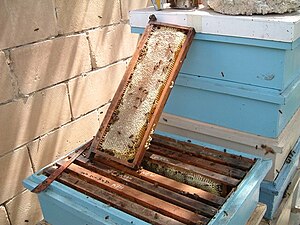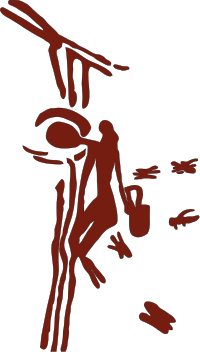Honey/ja: Difference between revisions
Created page with "養蜂の最初の記録は古代エジプトにあり、ハチミツはケーキ、ビスケット、その他の食品を甘くするために、またエジプトの象形文字では軟膏の基剤として使用された。エジプト、メソポタミア、その他の地域では、死者はしばしばハチミツの中またはハチミツとともに埋葬された。ハチ..." Tags: Mobile edit Mobile web edit |
Created page with "仏教では、ハチミツはインドとバングラデシュで祝われる''マドゥ・プルニマ''の祭りで重要な役割を果たす。この日は、ブッダが荒野に退いて弟子たちの間で平和を築いたことを記念する日である。伝説によると、彼がそこにいる間、サルが彼に食べるためのハチミツを持ってきたという。マドゥ・プ..." |
||
| (8 intermediate revisions by the same user not shown) | |||
| Line 320: | Line 320: | ||
養蜂の最初の記録は[[:en:ancient Egypt|古代エジプト]]にあり、ハチミツはケーキ、ビスケット、その他の食品を甘くするために、またエジプトの[[:en:hieroglyphs|象形文字]]では[[unguents/ja|軟膏]]の基剤として使用された。エジプト、[[:en:Ancient Mesopotamia|メソポタミア]]、その他の地域では、死者はしばしばハチミツの中またはハチミツとともに埋葬された。ハチは神殿に飼育され、神殿への供物、ミイラ化、その他の用途のためにハチミツを生産した。 | 養蜂の最初の記録は[[:en:ancient Egypt|古代エジプト]]にあり、ハチミツはケーキ、ビスケット、その他の食品を甘くするために、またエジプトの[[:en:hieroglyphs|象形文字]]では[[unguents/ja|軟膏]]の基剤として使用された。エジプト、[[:en:Ancient Mesopotamia|メソポタミア]]、その他の地域では、死者はしばしばハチミツの中またはハチミツとともに埋葬された。ハチは神殿に飼育され、神殿への供物、ミイラ化、その他の用途のためにハチミツを生産した。 | ||
南[[:en:Illyria|イリュリア]](現在の[[:en:Albania|アルバニア]])では、鉄器時代の[[:en:Illyrians|イリュリア人]]の部族である[[:en:Abroi|アブロイ]]が、紀元前6世紀に[[:en:Hecataeus of Miletus|ヘカタイオス・オブ・ミレトス]]によって記録されているように、ハチミツから作られる[[mead/ja|ミード]](ハチミツ酒)を準備することで知られていた。 | |||
[[:en:ancient Greece|古代ギリシャ]]では、[[:en:Archaic Greece|アルカイック期]]から[[:en:Hellenistic period|ヘレニズム期]]にかけてハチミツが生産された。紀元前594年、[[:en:Athens|アテネ]]周辺では養蜂が非常に普及していたため、[[:en:Solon|ソロン]]はそれに関する法律を制定した。「蜂の巣を設置する者は、すでに設置されているものから300フィート(約91メートル)離して設置しなければならない」。ギリシャの考古学発掘調査で発見された陶器から古代の蜂の巣が特定された。[[:en:Columella|コルメラ]]によると、ヘレニズム期のギリシャの養蜂家は、異なる地域の異なる植物サイクルを利用して生産を最大化するために、かなりの長距離にわたって巣箱を移動させることを躊躇しなかった。[[:en:ancient India|古代インド]]におけるハチミツの精神的および治療的とされる使用は、[[Vedas/ja|ヴェーダ]]と[[Ayurveda/ja|アーユルヴェーダ]]の両方の文献に記録されている。 | |||
==宗教的意義{{Anchor|Religious significance}}== | |||
== Religious significance == | [[:en:ancient Greek religion|古代ギリシャ宗教]]において、[[:en:Zeus|ゼウス]]と[[:en:Twelve Olympians|オリュンポス十二神]]の食物は、ネクターと[[:en:ambrosia|アンブロシア]]の形をしたハチミツであった。 | ||
[[:en:Hebrew Bible|ヘブライ語聖書]]では、[[:en:Promised Land|約束の地]](カナンの地、イスラエルの地)がその豊かさの比喩として16回「[[:en:Exodus 3|乳と蜜の流れる地]]」と描写されている。「ハチミツ」という言葉がヘブライ語聖書に登場する55回のうち、16回は「乳と蜜の流れる地」という表現の一部であり、「ハチミツ」がハチと明示的に関連付けられているのはわずか2回で、どちらも野生のハチに関連するものである。近代の聖書研究者は、聖書で用いられている元のヘブライ語(דבש, ''devash'')は、[[fig/ja|イチジク]]や[[Phoenix dactylifera/ja|ナツメヤシ]]から生産される[[Date honey/ja|甘いシロップ]]を指すものと長らく考えていた。これは、初期の聖書物語([[:en:Book of Exodus|出エジプト記]]、[[:en:Book of Judges|士師記]]、[[:en:Books of Kings|列王記]]など)に関連する時代において、[[:en:ancient Near East|古代近東]]のどこでも(エジプトを除く)ミツバチの家畜化が考古学的に全く文書化されていなかったためである。しかし、2005年、イスラエルの[[:en:Tel Rehov|テル・レホブ]]で紀元前10世紀に遡る養蜂場が発見され、100の巣箱が含まれており、年間500キログラムのハチミツを生産していたと推定されている。これは2007年現在、古代近東地域全体で考古学者によってなされた唯一のそのような発見であり、聖書のハチミツが実際にハチのハチミツであった可能性を開くものである。 | |||
[[File:May_you_all_have_a_sweet_year_(365-271)_(6194230350).jpg|thumb|[[Judaism|ユダヤ教]]において、ハチミツは新年「[[:en:Rosh Hashanah|ロシュ・ハシャナー]]」の甘さを象徴し、伝統的にリンゴのスライスとともに食べられる。]] | |||
[[File:May_you_all_have_a_sweet_year_(365-271)_(6194230350).jpg|thumb| | ユダヤ教の伝統において、ハチミツは新年「[[:en:Rosh Hashanah|ロシュ・ハシャナー]]」の象徴である。その祝日の伝統的な食事では、甘い新年をもたらすために、リンゴのスライスをハチミツに浸して食べる。一部のロシュ・ハシャナーの挨拶では、ハチミツとリンゴが描かれ、祝祭を象徴している。一部の会衆では、新年を迎えるために小さなハチミツのストローが配られる。純粋なハチミツは、飛翔昆虫である非コーシャの生き物によって生産されるにもかかわらず、[[:en:Kashrut|コーシャ]](宗教的なユダヤ人が食べることを許されている)と見なされている。非コーシャの動物の他の製品を食べることは禁じられている。肉も乳製品も含まない「パルベ」(中性)食品に属し、どちらとも一緒に食べることが許されている。 | ||
[[:en:Early Christianity|初期キリスト教徒]]は、洗礼式でハチミツを精神的な完璧さの象徴として使用した。 | |||
[[Early Christianity| | |||
イスラム教では、[[:en:Quran|クルアーン]]の全章([[:en:Surah|スーラ]])が「[[an-Nahl/ja|ミツバチ]]」と呼ばれている。彼の教え([[:en:hadith|ハディース]])によると、[[:en:Muhammad|ムハンマド]]は[[Prophetic medicine/ja|癒しの目的でハチミツ]]を強く推奨した。クルアーンはハチミツを栄養豊富で健康的な食品として促進し、次のように述べている。 | |||
{{blockquote|そしてあなたの主はミツバチに教えた。山々に、木々に、そして(人々の)住居に、その巣を作るようにと。それから(大地の)すべての産物を食べ、その主の広々とした道を巧みに見つけるようにと。それらの体の中から、様々な色の飲み物が出る。そこには人々にとって癒しがある。まことに、これには熟考する者にとってのしるしがある。}} | |||
{{blockquote| | |||
ヒンドゥー教では、ハチミツ(''[[Madhu/ja|Madhu]]'')は生命の5つのエリクシール(''[[Wikipedia:Panchamrita|Panchamrita]]'')の1つである。寺院では、''Madhu [[:en:abhisheka|アビシェカ]]''と呼ばれる儀式で、神々にハチミツが注がれる。''ヴェーダ''やその他の古代文献には、ハチミツが優れた薬用食品および健康食品として使用されていたことが記されている。 | |||
仏教では、ハチミツはインドとバングラデシュで祝われる''[[:en:Madhu Purnima|マドゥ・プルニマ]]''の祭りで重要な役割を果たす。この日は、[[:en:Gautama Buddha|ブッダ]]が荒野に退いて弟子たちの間で平和を築いたことを記念する日である。伝説によると、彼がそこにいる間、[[Old World monkey/ja|サル]]が彼に食べるためのハチミツを持ってきたという。マドゥ・プルニマには、仏教徒はこの行為を思い出し、[[:en:Buddhist monasticism|僧侶]]にハチミツを贈る。サルの贈り物は[[:en:Buddhist art|仏教美術]]によく描かれている。 | |||
==大衆文化において{{Anchor|Popular culture}}== | ==大衆文化において{{Anchor|Popular culture}}== | ||
Latest revision as of 10:18, 18 June 2025
ハチミツは、数種のハチによって作られる甘く粘性のある物質で、最もよく知られているのはミツバチである。ハチミツはハチのコロニーを養うために作られ、貯蔵される。ハチは、植物の糖分を含む分泌物(主に花の蜜)や、アブラムシの甘露など、他の昆虫の分泌物を集めて精製することでハチミツを生産する。この精製は、ハチ個体内での逆流や酵素活動によるものと、巣での貯蔵中に水分が蒸発してハチミツの糖分が濃縮され、とろみがついて粘性になることによって行われる。
ミツバチは巣にハチミツを貯蔵する。巣の中にはハニカムと呼ばれるワックスでできた構造があり、ハニカムは何百、何千もの六角形の部屋で構成されており、ハチはそこにハチミツを逆流させて貯蔵する。他のハチミツを生産するハチの種は、ハリナシミツバチが使用するワックスと樹脂で作られた壺など、異なる構造に物質を貯蔵する。
人間が消費するためのハチミツは、野生のハチのコロニーから、または家畜化されたハチの巣から収集される。ミツバチによって生産されるハチミツは、世界的な商業生産と入手可能性のおかげで、人間にとって最もなじみ深い。ハチの飼育は養蜂またはアピカルチャーとして知られ、ハリナシミツバチの飼育は通常メリポニカルチャーと呼ばれる。
ハチミツは、単糖類である果糖とブドウ糖の濃度が高いため甘い。スクロース(砂糖)とほぼ同じ相対的な甘さを持つ。標準的な大さじ1杯(14mL)のハチミツは、約180 kilojoules (43 kilocalories)の食物エネルギーを提供する。ベーキングにおいては魅力的な化学的特性を持ち、甘味料として使用すると独特の風味がある。ほとんどの微生物はハチミツ中では増殖できず、密閉されたハチミツは腐敗しない。考古学的文脈で発見されたハチミツのサンプルは、数千年経っても食用可能であることが証明されている。

ハチミツの使用と生産には長く多様な歴史があり、その始まりは先史時代に遡る。スペインのクエバス・デ・ラ・アラーニャにあるいくつかの洞窟壁画には、少なくとも8,000年前に人間がハチミツを採集している様子が描かれている。Apis melliferaは旧世界の昆虫であるが、新世界のハリナシミツバチの大規模なメリポニカルチャーは、プレコロンブス期以来、マヤ人によって行われてきた。
形成


ミツバチによる形成
ハチミツは、蜜や甘露を集めたミツバチによって生産される。ミツバチはハチミツの糖分を重宝しており、これを消費して一般的な代謝活動、特に採餌中の飛翔筋の活動を支え、幼虫の餌としている。この目的のために、ミツバチは通常の採餌中や、越冬時のような乏しい期間に備えてハチミツを貯蔵する。採餌中、ミツバチは集めた蜜の一部を使って飛翔筋を動かす。集めた蜜の大部分は、直接昆虫を養うために使われるのではなく、逆流、酵素的消化、そして最終的にハチミツとしての長期貯蔵のために運命づけられる。寒い季節や他の食物源が乏しい場合、成虫と幼虫のミツバチは貯蔵されたハチミツを消費する。これは、作られた蜜よりもはるかにエネルギー密度が高い。
巣を離れた採餌バチは、糖分が豊富な蜜や甘露を集める。花から得られる蜜は、通常70〜80%の水分を含み、水分含有量が約18%の完成したハチミツよりもはるかに粘性が低い。アブラムシや他のカメムシ目の昆虫から得られる甘露の水分含有量は、通常、それらの昆虫が餌とする樹液に非常に近く、蜜よりもわずかに希釈されていることが多い。ある情報源では、甘露の水分含有量は約89%であると説明されている。蜜であろうと甘露であろうと、ミツバチはこれらのサラサラした液体を口吻を通して吸い込み、その液体はミツバチの蜜胃、つまり「蜜嚢」に送られる。この腔は食物胃のすぐ上に位置し、食物胃は個々のミツバチが自身の栄養のために消費する花粉や糖分を消化する。
セイヨウミツバチの蜜胃は約40mgの液体を保持する。これは荷物を積んでいないミツバチの約半分の重さである。この量の蜜を集めるには、千以上の花を訪れる必要がある。蜜が豊富な場合でも、蜜胃を満たすのにミツバチは1時間以上の絶え間ない作業を要することがある。ミツバチの蜜胃に入ると、唾液酵素とミツバチの下咽頭腺からのタンパク質が蜜の中に分泌される。これらの物質は、スクロースやデンプンのような複合糖質をブドウ糖や果糖のようなより単純な糖に加水分解し始める。このプロセスは、部分的に消化された蜜の水分含有量と酸性度をわずかに上昇させる。
満たされると、採餌バチは巣に戻る。そこで蜜を吐き戻し、巣バチに渡す。巣バチも自身の蜜胃に入った蜜を吐き戻し、大顎の間で繰り返し泡を形成することで、その消化と濃縮を促進する。これらの泡は体積あたりの表面積を大きくし、これによりミツバチは蜜の水分の一部を巣の暖かい空気中に蒸発させる。
巣バチはハチミツ加工グループを形成する。これらのグループは連携して作業し、あるハチが加工された蜜を泡立ててから、精製された液体を他のハチに渡す。製品が貯蔵品質に達するまで、連続的な逆流、消化、蒸発に20分もかかることがある。新しいハチミツはハニカムの部屋に入れられ、蓋はされないままにされる。このハチミツはまだ水分含有量が非常に高く、集められた蜜の濃度にもよるが、最大70%にもなる。この精製の段階では、ハチミツの水分含有量が非常に高いため、どこにでもいる酵母の胞子がその中で繁殖できる。このプロセスは、放置すると新しいハチミツの糖分を急速に消費してしまう。これに対抗するため、ミツバチは昆虫としては珍しい能力、すなわち内因性の熱発生能力を用いる。
ミツバチは大量の体熱を生成できる数少ない昆虫の一つである。彼らはこの能力を使って、巣の中に一定の周囲温度を作り出す。ハチミツ貯蔵区域の巣の温度は、通常35 °C (95 °F)前後である。この温度は、体で熱を生成するか、水分の蒸発によって熱を除去することによって調節される。蒸発は貯蔵されたハチミツから水分を除去し、コロニーから熱を引き出す。ミツバチは羽を使って巣の冷却を制御する。協調的な羽ばたきは、湿ったハチミツ全体に空気を移動させ、水分と熱を排出する。巣の換気は、最終的に過剰な水分と熱を外界に排出する。
蒸発のプロセスは、ハチミツの最終的な水分含有量が15.5%から18%になるまで続く。これにより、糖分は水の飽和点をはるかに超えて濃縮される。つまり、ハチミツに残るわずかな水分には、同量の水に溶解できるよりもはるかに多くの糖分が溶解しているということである。したがって、ハチミツは、巣の温度であっても、水中の様々な糖の過冷却溶液である。このような高濃度の糖分は、室温近くで、より低濃度の溶液(この場合は蜜)の蒸発によってのみ達成できる。浸透圧の理由から、このような高濃度の糖分は微生物の繁殖に極めて不利であり、結果としてすべての発酵は停止する。その後、ミツバチは完成したハチミツの部屋にワックスで蓋をする。これにより、汚染から密閉され、さらなる蒸発が防がれる。
水分濃度が18%を大きく超えない限り、ハチミツは巣の中と養蜂家による除去後の両方で、無限の貯蔵寿命を持つ。
By other insects
ハチミツを生産する真社会性昆虫はミツバチだけではない。非寄生のマルハナバチとハリナシミツバチはすべてハチミツを生産する。南米および中米に生息するBrachygastra lecheguanaやBrachygastra mellificaなどの一部のスズメバチ種は、蜜を食べてハチミツを生産することが知られている。Polistes versicolorなどの他のスズメバチもハチミツを消費する。彼らは生活環の中盤で、タンパク質が豊富な花粉を食べるのと、はるかに高密度の食物エネルギー源であるハチミツを食べるのを交互に行う。
人間の介入
人間は、ミツバチの分蜂段階を利用して、いくつかのミツバチ種を半家畜化してきた。分蜂とは、コロニーの現在の巣に拡張する余地がなくなったときに、新しいコロニーを確立する手段である。古い女王は新しい女王に育つ卵を産み、その後、コロニーの半分もの数を率いて新しい巣の場所へ向かう。ミツバチは通常、この目的のために送り出された偵察バチが別の巣に適した場所を発見する前に分蜂する。そのような場所が見つかるまで、分蜂群はしばしば以前の巣の近く、多くは木の枝から固まっているだけである。これらの分蜂群は通常おとなしく、人間による輸送に適している。商業用のラングストロフ式巣箱のような適切な営巣場所が提供されると、分蜂群は人工的な環境でも容易に新しいコロニーを形成する。これらの半家畜化されたコロニーは、その後、養蜂やメリポニカルチャーを行う人間によって世話される。捕獲されたミツバチは、受粉媒介者が高く評価される果樹園などの農業環境で採餌を促されることが多い。ミツバチが生産するハチミツ、花粉、蜜蝋、樹脂はすべて、様々な用途のために人間によって収穫される。
「半家畜化」という用語が好まれるのは、非常に大規模な農業養蜂場であっても、すべてのミツバチコロニーが、成功した野生コロニーを確立できる分蜂群として、人間の保護下から容易に離れるためである。商業養蜂の努力の多くは、分蜂準備ができている巣に、現在の場所でより多くのハニカムを生産するように説得することに費やされる。これは通常、既存のコロニーの上に空の箱であるハニースーパーを追加することで、コロニーにより多くの空間を追加することによって行われる。これによりミツバチは通常、分蜂によってコロニーを分割する代わりに、この空きスペースを発展させるように誘引される。
生産
採取



ハチミツは野生のハチの群れ、または飼育された蜂の巣から採取される。平均して、1つの巣からは年間約65ポンド(約29.5 kg)のハチミツが生産される。野生のハチの巣は、ミツオシエという鳥を追うことによって見つけられることがある。
巣からハチミツを安全に採取するために、養蜂家は通常、養蜂用燻煙器を使ってハチを落ち着かせる。煙は摂食本能(巣の資源を火事から守ろうとする試み)を引き起こし、ハチを攻撃的でなくさせ、ハチがコミュニケーションに使うフェロモンを覆い隠す。ハニカムは巣から取り除かれ、ハチミツは圧搾するかハチミツ抽出器を使って抽出される。ハチミツは通常、蜜蝋やその他の破片を取り除くために濾過される。
取り外し可能な巣枠が発明される前は、収穫を行うためにハチの群れ全体を犠牲にすることがよくあった。収穫者は利用可能なすべてのハチミツを取り、翌春に群れ全体を置き換えた。取り外し可能な巣枠の発明以来、飼育の原則により、ほとんどの養蜂家は、蜂の巣にハチミツを残すか、砂糖水や結晶砂糖(しばしば「キャンディボード」の形で)のようなハチミツ代替品を群れに与えることによって、冬を乗り切るのに十分な貯蔵があることを確認している。冬を乗り切るために必要な食料の量は、ハチの種類、およびその地域の冬の長さと厳しさによって異なる。
多くの動物種が野生または家畜のハチミツ源に引き寄せられる。
保存
ハチミツは、その組成と化学的性質から、長期保存に適しており、長期保存後でも容易に消化される。ハチミツやハチミツに浸されたものは、何世紀にもわたって保存されてきた。(ただし、エジプトの墓で食用可能なハチミツが発見されたという例はなく、そのような場合はすべて他の物質であるか、化学的痕跡のみであることが証明されている。)保存の鍵は湿気へのアクセスを制限することである。硬化状態のハチミツは、発酵を抑制するのに十分な高い糖度を持っている。湿った空気にさらされると、その親水性の特性により、湿気をハチミツの中に引き込み、最終的には発酵が始まる点まで希釈される。
ハチミツの長い貯蔵寿命は、ハチの胃に見られる酵素に起因するとされている。ハチは、以前に摂取した放出された蜜とグルコースオキシダーゼを混ぜ合わせ、グルコン酸と過酸化水素という2つの副産物を生成する。これらはハチミツの酸性と細菌増殖の抑制に部分的に関与している。
混和(ごまかし)
ハチミツは、風味や粘度を変えたり、コストを削減したり、結晶化を抑えるために果糖の含有量を増やしたりする目的で、他の糖類、シロップ、または化合物を加えて混和されることがある。ハチミツは古代から混和されており、当時はメープル、白樺、ソルガムなどの植物シロップと混ぜて純粋なハチミツとして販売されることがあった。時には結晶化したハチミツに小麦粉やその他の充填剤が混ぜられ、ハチミツが液化するまで購入者にごまかしが隠されていた。現代では、最も一般的な混和剤は透明でほとんど無味のコーンシロップとなり、混和された混合物を純粋なハチミツと区別することは非常に困難になっている。
国連のコーデックス委員会によると、「ハチミツ」または「純粋なハチミツ」と表示された製品は混和されてはならないとされているが、表示に関する法律は国によって異なる。米国では、全米ハチミツ評議会によると、「ハチミツの真正性を確保することは、今日のハチミツ業界が直面している大きな課題の1つです。過去半世紀にわたり、食品詐欺を検出するための多くのハチミツ検査方法が開発されてきました。現在、すべての種類の混和を適切な感度で検出できる単一の普遍的な分析方法は利用できません。」
同位体比質量分析法は、炭素の同位体署名によってコーンシロップやサトウキビ糖の添加を検出するために使用できる。トウモロコシやサトウキビ(ミツバチが利用する植物とは異なりC4植物であり、主にC3植物であるテンサイも)に由来する糖の添加は、ハチミツ中に存在する糖の同位体比を歪めるが、タンパク質の同位体比には影響しない。混和されていないハチミツでは、糖とタンパク質の炭素同位体比は一致するはずである。7%という低い添加レベルでも検出が可能である。
生産
| 463,500 | |
| 114,886 | |
| 84,591 | |
| 80,389 | |
| 73,395 | |
| 62,855 | |
| 世界 | 1,893,805 |
| 出典: 国連食糧農業機関統計局 | |
2023年における世界のハチミツ生産量は190万トンであり、中国が総生産量の24%を占め、トルコ、エチオピア、イランがそれに続く生産国であった(表)。
現代における利用
食品
食品としての歴史の中で、ハチミツの主な用途は、料理、ベーキング、デザート、パンのスプレッド、紅茶などの様々な飲料への添加、そして一部の市販飲料の甘味料としてである。
エネルギー密度が高いため、ハチミツは温暖な気候に住む事実上すべての狩猟採集民文化にとって重要な食品であり、ハッザ族はハチミツをお気に入りの食品としている。アフリカのハチミツ採集者は、特定のミツオシエ鳥と相利共生関係にある。
発酵食品
おそらく世界最古の発酵飲料であり、9,000年前にまで遡るミード(「蜂蜜酒」)は、ハチミツと水を混ぜたマストに酵母を加え、数週間から数ヶ月間発酵させて作られるアルコール飲料である。現代のミード生産では、酵母Saccharomyces cerevisiaeが一般的に使用される。
ミードの種類には、メセグリン(スパイスやハーブ入り)、メロメル(果汁入り、特にブドウ果汁入りはパイメントと呼ばれる)、ヒポクラス(シナモン入り)、サックミード(高濃度のハチミツ入り)などがあり、その多くは米国で数百種類に及ぶ市販製品として開発されている。ハチミツは「ブラッゴット」と呼ばれるミードビールの製造にも使用される。
物理的および化学的特性

ハチミツの物理的特性は、水分含有量、それを生産するために使用された植物の種類(蜜源)、温度、および含まれる特定の糖の割合によって異なる。採れたてのハチミツは過飽和液体であり、常温で水が通常溶解できるよりも多くの糖を含んでいる。室温では、ハチミツは過冷却液体であり、ブドウ糖が固体の顆粒として析出する。これにより、果糖と他の成分の溶液中に析出したブドウ糖の結晶の半固体溶液が形成される。
ハチミツの密度は、通常20℃で1.38から1.45 kg/Lの範囲である。
相転移
結晶化したハチミツの融点は、その組成に依存するが、40〜50℃である。この温度を下回ると、ハチミツは準安定状態にあり、種結晶が加えられるまで結晶化しないか、またはより一般的には「不安定な」状態にあり、自然に結晶化するのに十分な糖で飽和している。結晶化の速度は多くの要因に影響されるが、主要な要因は主糖である果糖とブドウ糖の比率である。アブラナハチミツのようにブドウ糖の割合が非常に高く過飽和状態のハチミツは、採蜜後ほぼ直ちに結晶化するが、栗やニッサハチミツのようにブドウ糖の割合が低いハチミツは結晶化しない。ハチミツの種類によっては、結晶は少ないが非常に大きな結晶を生成するものもあれば、多くの小さな結晶を生成するものもある。
結晶化は水分含有量にも影響され、水分含有量が高いと結晶化が抑制されるのと同様に、デキストリン含有量が高い場合も結晶化が抑制される。温度も結晶化の速度に影響を与え、最も速い成長は13〜17℃で起こる。結晶核(種)は、ハチミツを静置するよりも、かき混ぜたり、振ったり、攪拌したりして撹拌すると、より容易に形成される傾向がある。しかし、微細な種結晶の核生成は5〜8℃の間で最も大きい。したがって、より大きいが数の少ない結晶はより高い温度で形成される傾向があり、より小さいが数の多い結晶は通常より低い温度で形成される。5℃を下回ると、ハチミツは結晶化せず、元の食感と風味を無期限に保つことができる。
ハチミツは、通常通り融点以下で保存すると過冷却液体である。非常に低い温度でも、ハチミツは固く凍結することはない。むしろその粘度が増加する。ほとんどの粘性液体と同様に、ハチミツは温度が低下するにつれて濃く、動きが鈍くなる。-20℃では、ハチミツは固体に見える、あるいは手触りもそうであるかもしれないが、非常に低い速度で流れ続ける。ハチミツは-42℃から-51℃の間でガラス転移を起こす。この温度を下回ると、ハチミツはガラス状態になり、アモルファス固体(非晶質)となる。
レオロジー

ハチミツの粘度は、温度と水分含有量の両方に大きく影響される。水分含有量が高いほど、ハチミツはより容易に流動する。しかし、融点を超えると、水分は粘度にほとんど影響を与えない。水分含有量以外では、ほとんどの種類のハチミツの組成も粘度にはほとんど影響しない。25℃で水分含有量14%のハチミツは、一般に約400ポアズの粘度を持つが、水分含有量20%のハチミツは、約20ポアズの粘度を持つ。粘度は適度な冷却で非常にゆっくりと増加する。水分含有量16%のハチミツは、70℃で約2ポアズの粘度を持つが、30℃では粘度が約70ポアズとなる。さらに冷却すると、粘度の増加はより急速になり、約14℃で600ポアズに達する。しかし、ハチミツは粘性があるが、表面張力は50〜60 mJ/m<sup>2</sup>と低く、濡れ性は水、グリセリン、または他のほとんどの液体と同様である。ハチミツの高い粘度と濡れ性により粘着性が生じるが、これはガラス転移温度(T<sub>g</sub>)と結晶融解温度の間で過冷却液体における時間依存のプロセスである。
ほとんどの種類のハチミツはニュートン流体であるが、一部の種類のハチミツは非ニュートン粘性特性を示す。ヘザーやマヌカのハチミツはチクソトロピー性を示す。これらの種類のハチミツは、静止しているときはゲル状になるが、かき混ぜると液化する。
電気的および光学的特性
ハチミツには酸やミネラルという形で電解質が含まれるため、様々な程度の電気伝導率を示す。電気伝導率の測定は、灰分量によってハチミツの品質を判断するために使用される。
ハチミツが光に与える影響は、その種類と品質を判断するのに役立つ。水分含有量の変化は屈折率を変化させる。水分含有量は屈折計で簡単に測定できる。通常、ハチミツの屈折率は、水分含有量13%で1.504から25%で1.474の範囲である。ハチミツは偏光にも影響を与え、偏光面を回転させる。果糖は負の回転を与え、ブドウ糖は正の回転を与える。全体の回転は混合比を測定するために使用できる。ハチミツの色は一般的に淡黄色から濃い茶色であるが、糖源によっては他の色も生じることがある。例えば、クズ(Pueraria montana var. lobata)の花から採蜜するミツバチの群れは、赤から紫の色に変化するハチミツを生産する。
吸湿性と発酵
ハチミツは空気中の水分を直接吸収する能力があり、この現象は吸湿性と呼ばれる。ハチミツが吸収する水分の量は、空気の相対湿度に依存する。ハチミツには酵母が含まれているため、この吸湿性により、ハチミツは密封容器に保管する必要がある。これは、ハチミツの水分含有量が25%を大幅に超えると通常始まる発酵を防ぐためである。ハチミツは、個々の糖が単独で許容するよりも多くの水分をこの方法で吸収する傾向があり、これはハチミツに含まれる他の成分に起因する可能性がある。
ハチミツの発酵は通常、結晶化後に起こる。なぜなら、ブドウ糖がないと、ハチミツの液体部分は主に果糖、酸、水の濃縮混合物で構成され、酵母の増殖に必要な水分割合の増加を十分に提供するためである。長期間室温で保存するハチミツは、酵母を殺すために70℃以上に加熱してパスチャライズ処理されることが多い。
熱特性

すべての糖化合物と同様に、ハチミツは十分に加熱するとキャラメル化し、色が濃くなり、最終的には焦げる。しかし、ハチミツにはブドウ糖よりも低い温度でキャラメル化する果糖が含まれている。キャラメル化が始まる温度は組成によって異なるが、通常70〜110℃である。ハチミツには酸も含まれており、これがキャラメル化の触媒として作用する。特定の種類の酸とその量は、正確な温度を決定する上で主要な役割を果たす。これらの酸のうち、ごく少量存在するアミノ酸は、ハチミツの褐変に重要な役割を果たす。アミノ酸は、メイラード反応中にメラノイジンと呼ばれる褐変化合物を形成する。メイラード反応は室温ではゆっくりと進行し、目に見える褐変が現れるまでに数ヶ月から数ヶ月かかるが、温度が上昇すると劇的に加速する。しかし、ハチミツを低温で保存することで反応を遅らせることもできる。
他の多くの液体とは異なり、ハチミツの熱伝導率は非常に悪く、水分含有量13%で0.5 W/(m⋅K)(銅の401 W/(m⋅K)と比較)であり、熱平衡に達するまでに長い時間がかかる。動粘度が高いため、ハチミツは運動量拡散(対流)ではなく、熱拡散(より固体に近い)によって熱を伝達するため、加熱源が熱すぎたり均一に分散していなかったりすると、結晶化したハチミツを溶かすと局所的なキャラメル化が容易に起こる可能性がある。しかし、ハチミツは融点よりわずかに高い温度よりも、高い温度で液化するのに実質的に長い時間がかかる。20 kgの結晶化したハチミツを40℃で溶かすのに最大24時間かかることがあり、50 kgではその2倍の時間がかかる場合がある。これらの時間は50℃で加熱することでほぼ半分に短縮できる。しかし、ハチミツに含まれる多くの微量物質は加熱によって大きく影響を受け、風味、香り、その他の特性が変化する可能性があるため、加熱は通常、可能な限り最低温度で最短時間で行われる。
酸含量と風味への影響
ハチミツの平均pHは3.9であるが、3.4から6.1の範囲である。ハチミツには有機酸とアミノ酸の両方を含む多くの種類の酸が含まれる。しかし、その種類と量は、ハチミツの種類によって大きく異なる。これらの酸は芳香族または脂肪族(非芳香族)である場合がある。脂肪族酸は、
有機酸はハチミツ中の酸の大部分を構成し、混合物の0.17〜1.17%を占める。その中で、グルコースオキシダーゼの作用によって形成されるグルコン酸が最も豊富に存在する。他に少量の有機酸として、ギ酸、酢酸、酪酸、クエン酸、乳酸、リンゴ酸、ピログルタミン酸、プロピオン酸、吉草酸、カプロン酸、パルミチン酸、コハク酸など、多数のものが存在する。
揮発性有機化合物
異なる植物源由来の個々のハチミツには100種類以上の揮発性有機化合物(VOC)が含まれており、これらはハチミツの風味と香りを決定する上で主要な役割を果たす。VOCは空気中に容易に揮発する炭素ベースの化合物であり、花の香り、精油、熟した果物の香りなど、香りを提供する。ハチミツ中に見られるVOCの典型的な化学族には、炭化水素、アルデヒド、アルコール、ケトン、エステル、酸、ベンゼン、フラン、ピラン、ノルイソプレノイド、テルペンなど、多数の化合物とその誘導体が含まれる。特定のVOCとその量は、異なる植物源から採蜜されるハチミツの種類によって大きく異なる。例えば、あるレビューで異なるハチミツ中のVOCの混合物を比較すると、リュウガンハチミツは揮発性物質の量が多かった(48種類のVOC)のに対し、ヒマワリハチミツは揮発性物質の数が最も少なかった(8種類のVOC)。
VOCは主に蜜からハチミツに導入され、花によって個々の香りを付与する。特定のVOCの種類と濃度は、単花性ハチミツを生産するために使用されたフローラの種類を決定するために使用できる。フローラが育つ特定の地理、土壌組成、酸性度も、リュウガンハチミツの「フルーティーな」または「草のような」香りや、ヒマワリハチミツの「ワックスのような」香りなど、ハチミツの香りの特性に影響を与える。ある研究で優勢なVOCは、リナロールオキシド、トランス-リナロールオキシド、2-フェニルアセトアルデヒド、ベンジルエタノール、イソホロン、メチルノナノエートであった。
VOCはミツバチの体から導入されることもあり、消化の酵素作用によって生成されることもあれば、貯蔵中にハチミツ内の異なる物質間の化学反応によって生成されることもあり、したがって長期間にわたって変化したり、増減したりする場合がある。VOCは温度と加工によって生成されたり、変化したり、大きく影響されたりする場合がある。一部のVOCは熱に不安定であり、高温で破壊されるが、他のVOCはメイラード反応などの非酵素的反応中に生成される場合がある。VOCはハチミツが生成する香りのほぼすべてを担っており、その香りは「甘い」、「花のよう」、「柑橘系」、「アーモンド」、「酸っぱい」などの言葉で表現される場合がある。さらに、VOCは香りだけでなく風味を通じて、ハチミツの特定の風味を決定する上で大きな役割を果たす。異なる地理的地域のハチミツ由来のVOCは、それらの地域の花の特徴、および蜜を採集したミツバチの特徴として使用できる。
分類
ハチミツは、その供給源(花の蜜か否か)によって分類され、包装や加工方法に応じて区分される。地域ハチミツも識別される。米国では、ハチミツは米国農務省(USDA)の基準に基づいて色と光学密度で等級付けされ、「水のように白い」ハチミツの0から「濃い琥珀色」のハチミツの114を超えるまでのプファンドスケール
植物源
一般的に、ハチミツはそれが作られた蜜の花の供給源によって分類される。ハチミツは特定の種類の花の蜜から作られる場合もあれば、採集後にブレンドされる場合もある。ハチミツ中の花粉は花の供給源、ひいては原産地域を特定できる。ハチミツのレオロジー的およびメリソパリン学的特性は、その生産に使用された主要な植物の蜜源を特定するために使用できる。
単花蜜
単花蜜は主に一種類の花の蜜から作られる。単花蜜は、主要な蜜源の違いにより、独特の風味と色を持つ。単花蜜を生産するために、養蜂家はミツバチが可能な限り一種類の花のみにアクセスできる地域に蜂の巣を置く。実際には、どんな単花蜜にも少量の他の種類の花蜜が混ざる。北米の代表的な単花蜜の例としては、クローバー、オレンジブロッサム、セージ、チューペロ、ソバ、ファイヤーウィード、メスキート、サワーウッド、チェリー、ブルーベリーがある。ヨーロッパの代表的な例には、タイム、アザミ、ヘザー、アカシア、タンポポ、ヒマワリ、ラベンダー、スイカズラ、そしてシナノキやクリの木に由来する品種がある。北アフリカ(例えばエジプト)では、クローバー、綿、柑橘類(主にオレンジブロッサム)などが例として挙げられる。オーストラリア固有の植物相は多くの独特なハチミツを生み出し、その中でも最も人気があるのはイエローボックス、ブルーガム、アイアンバーク、ユーカリ・マリー、タスマニアのレザーウッド、そしてマカダミアである。
百花蜜
百花蜜は、ワイルドフラワーハニーとも呼ばれ、多種類の花の蜜から採取される。その味は年ごとに異なる場合があり、開花する花の種類によって香りと風味の強度が異なったり、強弱がついたりすることがある。
甘露蜜
甘露蜜は、ミツバチがマツ、モミ、クリ、カシなどの樹木から直接分泌物を取り込んだり、主に甘露、つまりアブラムシや他の植物の汁を吸う昆虫の甘い分泌物を採取して生産されるハチミツであり、花の蜜からは作られない。このハチミツは、淡い花蜜ハチミツよりも消化されにくい成分の割合がはるかに大きいため、ミツバチに赤痢を引き起こすことがある。甘露蜜は、蜜源ハチミツよりも風味が強く甘さが控えめであり、ヨーロッパ諸国が甘露蜜の主要市場となっている。ギリシャでは、甘露蜜の一種であるマツハチミツがハチミツ生産量の60〜65%を占める。
包装と加工による分類

一般的にハチミツは馴染みのある液体状で瓶詰めされるが、他の形態でも販売され、様々な加工方法が施されることがある。
- 結晶ハチミツは、ブドウ糖の一部が溶液から一水和物として自発的に結晶化したものである。「粒状ハチミツ」または「キャンディハチミツ」とも呼ばれる。結晶化したハチミツ(または市販の結晶化したハチミツ)は、温めることで液状に戻すことができる。よくある誤解とは異なり、ハチミツが結晶化することは期限切れを意味しない。
- パスチャライズ処理されたハチミツは、70℃以上の温度を必要とするパスチャライゼーション処理で加熱されたものである。パスチャライゼーションは酵母細胞を破壊する。また、ハチミツ中の微結晶を液化させ、目に見える結晶化の開始を遅らせる。しかし、過度な熱にさらされると、ヒドロキシメチルフルフラール(HMF)のレベルが増加し、酵素(例:ジアスターゼ)の活性が低下するため、製品の劣化も引き起こす。熱はハチミツを暗くし、味と香りに影響を与える。
- 生ハチミツは、蜂の巣の中に存在する状態、または加熱を加えず(「最小限の加工」が施された一部のハチミツも生ハチミツと表示されることがあるが)、抽出、沈殿、または濾過によって得られたものである。生ハチミツには花粉が含まれており、少量の蜜蝋の粒子が含まれることがある。
- ストレーンハチミツは、花粉、ミネラル、酵素を除去せずに、微粒子(蜜蝋の破片、プロポリス、その他の異物)を除去するためにメッシュ素材を通したものである。
- フィルターハチミツは、通常懸濁している微粒子、花粉粒、気泡、その他の物質のすべてまたはほとんどを除去する程度に濾過されたものである。このプロセスでは通常、フィルターをより容易に通過させるためにハチミツを65〜77℃に加熱する。フィルターハチミツは非常に透明で、結晶化が遅いため、スーパーマーケットで好まれる。最も一般的な方法は、140℃に加熱されたハチミツに珪藻土を加え、フィルター上に珪藻土のケーキが形成されるまで濾紙またはキャンバスを通して濾過するものである。
- 超音波処理ハチミツは、ハチミツの非熱加工代替法である超音波処理によって加工されたものである。ハチミツが超音波処理されると、ほとんどの酵母細胞が破壊される。超音波処理を生き残った細胞は通常、増殖能力を失い、ハチミツの発酵速度を実質的に減少させる。超音波処理はまた、既存の結晶を除去し、ハチミツのさらなる結晶化を抑制する。超音波補助による液化は、約35℃という実質的に低い温度で機能し、液化時間を30秒未満に短縮することができる。
- クリームハチミツは、ホイップハチミツ、スパンハチミツ、チャーンハチミツ、ハニーフォンダン、英国ではセットハチミツとも呼ばれ、結晶化を制御するために加工されたものである。クリームハチミツには多数の小さな結晶が含まれており、未加工のハチミツに起こりうる大きな結晶の形成を防ぐ。この加工により、滑らかで塗りやすい状態のハチミツも生産される。
- 乾燥ハチミツは、液状ハチミツから水分を除去し、完全に固形の、べたつかない顆粒にしたものである。このプロセスには、乾燥剤や固結防止剤の使用が含まれる場合と含まれない場合がある。乾燥ハチミツは焼き菓子やデザートの飾り付けに使われる。
- コムハチミツは、ミツバチの蜜蝋の巣房にそのまま入っているものである。伝統的に、ハニースーパーの標準的な木製巣枠を使って採取される。巣枠が採取され、コムは包装前に塊に切り出される。この労働集約的な方法の代替として、コムの手動切断を必要とせず、包装を迅速化できるプラスチック製のリングやカートリッジを使用することもできる。伝統的な方法で採取されたコムハチミツは、「カットコムハチミツ」とも呼ばれる。
- チャンクハチミツは、広口容器に詰められたもので、採取された液状ハチミツに一つまたは複数のコムハチミツの塊が浸されている。
- ハチミツ煎じ液は、ハチミツまたはハチミツ副産物を水に溶かし、その後煮詰めて(通常は沸騰させて)作られる。その後、他の材料が加えられることもある。(例えば、アッバメーレには柑橘類が加えられる。)結果として得られる製品は糖蜜に似ていることがある。
- ベイカーズハチミツは、「異質な」味や香り、または発酵が始まっていたり過熱されたりしたため、ハチミツの通常の仕様から外れるものである。これは一般的に食品加工の材料として使用される。ベイカーズハチミツの表示には追加の要件があり、単に「ハチミツ」として販売することはできない。
格付け
各国でハチミツの格付け基準は異なる。 米国では、ハチミツの格付けは米国農務省(USDA)の基準に基づいて自主的に行われている。USDAは「オンライン(工場内)またはロット検査として…申請に基づき、有料で」検査と格付けを提供している。ハチミツは、水分含有量、風味と香り、欠陥の有無、透明度など、多くの要因に基づいて格付けされる。ハチミツは色によっても分類されるが、これは格付け基準には含まれない。
USDAのハチミツ格付け基準は以下の通りである:
| グレード | 可溶性固形分 | 風味と香り | 欠陥の有無 | 透明度 |
|---|---|---|---|---|
| A | ≥ 81.4% |
|
|
|
| B | ≥ 81.4% |
|
|
|
| C | ≥ 80.0% |
|
|
|
| 規格外 | Cグレードに満たない | Cグレードに満たない | Cグレードに満たない | Cグレードに満たない |
インドは、フィーエ試験やその他の経験的測定値などの追加要因に基づいてハチミツの等級を認定している。
品質指標
高品質なハチミツは、その香り、味、粘稠度によって区別できます。20°C(68°F)の熟成した新鮮な高品質ハチミツは、ナイフから途切れることなくまっすぐな筋になって流れ落ちるはずです。流れ落ちたハチミツはビーズ状になるべきです。ハチミツを注ぐと、小さな一時的な層が比較的速やかに消え、高い粘度を示します。そうでなければ、水分含有量が20%を超えていることを示しており、長期保存には適していません。
瓶に入った新鮮なハチミツは、純粋で均一な液体に見え、層をなして固まることはありません。抽出から数週間から数ヶ月以内に、多くの種類のハチミツはクリーム色の固体に結晶化します。チューペロ、アカシア、セージなどの一部のハチミツは、結晶化しにくい傾向があります。結晶化を遅らせる、または抑制するために、瓶詰め時に40~49°C(104~120°F)の温度で加熱されることがあります。過熱は酵素レベルの変化によって示され、例えば、ジアスターゼ活性はシャーデ法またはファデバス法で測定できます。ハチミツの表面にふわふわした膜(白い泡のようなもの)や、容器の側面に大理石状または白い斑点状の結晶化が見られるのは、瓶詰めプロセス中に閉じ込められた気泡によって形成されたものです。
2008年のイタリアの研究では、核磁気共鳴分光法が異なるハチミツの種類を区別するために使用でき、生産された地域を特定できることが判明しました。研究者たちは、アカシアハチミツと百花蜜のフルクトースとスクロースの異なる割合、および芳香族アミノ酸であるフェニルアラニンとチロシンの異なるレベルによって違いを特定することができました。この能力により、適合する在庫をより簡単に選択できます。
栄養
| Nutritional value per 100 g (3.5 oz) | |||||||||||||||||||||||||||||||||||||||
|---|---|---|---|---|---|---|---|---|---|---|---|---|---|---|---|---|---|---|---|---|---|---|---|---|---|---|---|---|---|---|---|---|---|---|---|---|---|---|---|
| Energy | 1,270 kJ (300 kcal) | ||||||||||||||||||||||||||||||||||||||
82 g | |||||||||||||||||||||||||||||||||||||||
| Sugars | 82 g 36 g 41 g | ||||||||||||||||||||||||||||||||||||||
| Dietary fiber | 0.2 g | ||||||||||||||||||||||||||||||||||||||
0 g | |||||||||||||||||||||||||||||||||||||||
0.3 g | |||||||||||||||||||||||||||||||||||||||
| |||||||||||||||||||||||||||||||||||||||
| Other constituents | Quantity | ||||||||||||||||||||||||||||||||||||||
| Water | 17 g | ||||||||||||||||||||||||||||||||||||||
| †Percentages estimated using US recommendations for adults, except for potassium, which is estimated based on expert recommendation from the National Academies. | |||||||||||||||||||||||||||||||||||||||
ハチミツは水分17%、炭水化物82%で、食物繊維やタンパク質はごくわずかであり、脂肪は含まれていない(表)。ハチミツには重要な微量栄養素は含まれていない(表)。100gの基準量で、ハチミツは300カロリーを供給する(表)。
糖プロファイル
ハチミツは主に果糖(糖類の41%)とブドウ糖(36%)であり(表)、残りの糖類はガラクトース、マルトース、スクロースで構成され、それぞれ総糖類の3%以下を供給する(表、USDA参照)。
ハチミツのグリセミック指数は、種類によって31〜78の範囲になりうる。
ハチミツの特定の組成、色、香り、風味は、そのハチミツを生産したミツバチが採餌した花に依存する。
医療用途と研究
創傷と火傷
ハチミツは、火傷やその他の皮膚損傷に対する民間療法として用いられている。予備的な証拠によれば、ハチミツは部分層熱傷の治癒を他のドレッシングよりも4〜5日早く促進する可能性が示唆されており、中程度の証拠によれば、ハチミツで治療された術後感染症は、消毒薬やガーゼを用いるよりも早く、合併症も少なく治癒する可能性が示唆されている。他の様々な創傷治療におけるハチミツの使用に関する証拠は質が低く、確固たる結論を導き出すことはできない。静脈うっ滞性潰瘍や巻き爪の治療にハチミツベースの製品を使用することを裏付ける証拠はない。いくつかの医療用ハチミツ製品は、軽度の創傷や火傷の治療用として米国の食品医薬品局によって承認されている。
抗生物質
ハチミツは、伝統医学や生薬の施術者によって、局所抗生物質として長年使用されてきた。ハチミツの抗菌効果は、1892年にオランダの科学者ベルナルドゥス・アドリアヌス・ファン・ケテルによって初めて実証された。それ以来、数多くの研究により、ハチミツがグラム陽性菌とグラム陰性菌に対して広範囲の抗菌活性を持つことが示されているが、その効力はハチミツの種類によって大きく異なる。過去数十年間における抗生物質耐性菌の増殖により、ハチミツの抗菌特性に関する研究への関心が再燃している。潜在的な抗生物質としての使用について予備研究中のハチミツの成分には、メチルグリオキサール、過酸化水素、ロイヤリシン(ディフェンシン-1とも呼ばれる)がある。
咳
慢性および急性咳嗽に対して、コクランのレビューでは、ハチミツ使用の賛否を裏付ける強力な証拠は見つからなかった。小児の治療については、システマティックレビューにより、ハチミツが治療なし、ジフェンヒドラミン、プラセボよりも咳の緩和に役立つという中程度から低い質の証拠があると結論付けられた。ハチミツは小児の咳の緩和においてデキストロメトルファンよりも効果があるようには見えない。他のレビューも、小児の治療におけるハチミツの使用を支持している。
英国の医薬品・医療製品規制庁は、6歳未満の子供に市販の咳止めや風邪薬を与えることを避けるよう勧告しており、「ハチミツとレモンを含む自家製の治療法は、同様に有用で安全である可能性が高い」と示唆しているが、乳児ボツリヌス症のリスクがあるため、乳児にハチミツを与えないよう警告している。世界保健機関は、市販薬よりも効果が低いと信じる理由はないと述べ、子供を含む咳と喉の痛みの治療薬としてハチミツを推奨している。
その他
ハチミツの使用は、既知または疑われるボタン電池の摂取において、電池が除去される前に電池によって引き起こされる食道への損傷のリスクと重症度を軽減するための暫定的な介入として推奨されている。
ハチミツががんの治療に有益であるという証拠はないが、がん治療に用いられる放射線療法や化学療法の副作用を管理するのに役立つ可能性はある。
花粉による季節性アレルギーの治療法として摂取が提唱されることがあるが、その主張を裏付ける科学的証拠は決定的ではない。ハチミツは一般的にアレルギー性結膜炎の治療には効果がないと考えられている。
ハチミツのカロリーの大部分は果糖に由来する。通常の食事に加えて摂取すると、果糖は有意な体重増加を引き起こすが、果糖を同等のエネルギー価値を持つ他の炭水化物に置き換えた場合、体重に影響はなかった。
ハチミツには穏やかな下剤効果があり、便秘や腹部膨満の緩和に役立つと指摘されている。
健康上の危険性
ハチミツは、通常の食品量で摂取する分には一般的に安全である。しかし、過剰な摂取、既存の疾患、または薬剤との組み合わせによっては、さまざまな潜在的な副作用や薬物相互作用が生じる可能性がある。これらには、ある研究によると、約10%の子供に見られる不安、不眠症、多動症などの高摂取による軽度な反応が含まれる。別の研究によると、ハチミツ摂取による不安、不眠症、多動症の症状はプラセボと比較して検出されなかった。ハチミツの摂取は、既存のアレルギー、高血糖値(糖尿病など)、または出血をコントロールするために使用される抗凝固剤など、他の臨床状態と有害に相互作用する可能性がある。
免疫系が弱っている人は、ハチミツを摂取することで細菌や真菌の感染のリスクがあるかもしれない。
ボツリヌス症
乳児は、Clostridium botulinumの内生胞子に汚染されたハチミツを摂取するとボツリヌス症を発症する可能性がある。
乳児ボツリヌス症は地域差が見られる。英国では1976年から2006年の間にわずか6例しか報告されていないが、米国でははるかに高い発生率を示しており、出生10万人あたり1.9人で、その47.2%がカリフォルニア州である。ハチミツが乳児の健康にもたらすリスクは小さいものの、生後1年が経過するまでは摂取を推奨せず、それ以降のハチミツ摂取は安全であると考えられている。
毒性ハチミツ
狂い蜜中毒は、グラヤノトキシンを含むハチミツを摂取した結果である。シャクナゲ、アメリカシャクナゲ、ヒツジシャクナゲ、ツツジの花から生産されたハチミツは、ハチミツ中毒を引き起こす可能性がある。症状には、めまい、脱力感、過剰な発汗、吐き気、嘔吐が含まれる。まれに低血圧、ショック、心臓のリズム不整、けいれんが起こることもあり、ごくまれに死に至ることもある。FDAによると、ハチミツ中毒は、商業的な加工(多くの供給源からのハチミツを混ぜる)が毒素を希釈するため、小規模な養蜂家から「天然の」未加工ハチミツを使用する場合により起こりやすい。
毒性ハチミツは、ミツバチがツツ(Coriaria arborea)の茂みとブドウホッパー(Scolypopa australis)という昆虫の近くにいる場合にも発生する可能性がある。これらは両方ともニュージーランド全土に生息している。ミツバチは、ツツ植物を食べるブドウホッパー昆虫が生成する甘露を収集する。これにより、ツチンという毒がハチミツに混入する。ニュージーランドのいくつかの地域(コラマンデル半島、イースタンプレンティ湾地域、マールボロ・サウンズ)のみが頻繁に毒性ハチミツを生産している。ツチン中毒の症状には、嘔吐、せん妄、めまい、興奮性亢進、昏睡、重度のけいれんが含まれる。ツチン中毒のリスクを減らすため、ニュージーランドのリスク地域で野生の巣から採取されたハチミツを摂取すべきではない。2001年12月以降、ニュージーランドの養蜂家は、養蜂場の3マイル(約4.8 km)以内のツツ、ブドウホッパー、採餌状況を厳密に監視することで、毒性ハチミツ生産のリスクを低減することが義務付けられている。中毒が危険であることはまれである。
民間療法
神話や民間療法において、ハチミツは胃の不調、潰瘍、皮膚傷、皮膚の火傷など様々な病気を治療するために、古代ギリシャ人やエジプト人、アーユルヴェーダ、中国伝統医学で、経口および局所的に使用された。
歴史

ハチミツの採取は、ミツバチの家畜化よりもはるかに古い活動であり、この伝統的な慣習はハチミツ狩りとして知られている。スペインのバレンシアにある洞窟で発見された、少なくとも8000年前に遡る中石器時代の岩絵には、2人のハチミツ採集者が野生のハチの巣からハチミツとハニカムを採取している様子が描かれている。人物はカゴやヒョウタンを運び、ハチの巣に到達するためにハシゴや一連のロープを使用している。人類はオオミツオシエという鳥を追って野生の蜂の巣を見つけており、この行動は初期のヒト族とともに進化した可能性がある。最も古い既知のハチミツの残骸は、バクー・トビリシ・ジェイハンパイプラインの建設中にジョージアで発見された。考古学者は、紀元前4700年から5500年前の古代の墓で発掘された土器の内面からハチミツの残骸を発見した。古代ジョージアでは、死後の旅のために、菩提樹、ベリー、牧草地の花など、数種類のハチミツが埋葬された。
養蜂の最初の記録は古代エジプトにあり、ハチミツはケーキ、ビスケット、その他の食品を甘くするために、またエジプトの象形文字では軟膏の基剤として使用された。エジプト、メソポタミア、その他の地域では、死者はしばしばハチミツの中またはハチミツとともに埋葬された。ハチは神殿に飼育され、神殿への供物、ミイラ化、その他の用途のためにハチミツを生産した。
南イリュリア(現在のアルバニア)では、鉄器時代のイリュリア人の部族であるアブロイが、紀元前6世紀にヘカタイオス・オブ・ミレトスによって記録されているように、ハチミツから作られるミード(ハチミツ酒)を準備することで知られていた。
古代ギリシャでは、アルカイック期からヘレニズム期にかけてハチミツが生産された。紀元前594年、アテネ周辺では養蜂が非常に普及していたため、ソロンはそれに関する法律を制定した。「蜂の巣を設置する者は、すでに設置されているものから300フィート(約91メートル)離して設置しなければならない」。ギリシャの考古学発掘調査で発見された陶器から古代の蜂の巣が特定された。コルメラによると、ヘレニズム期のギリシャの養蜂家は、異なる地域の異なる植物サイクルを利用して生産を最大化するために、かなりの長距離にわたって巣箱を移動させることを躊躇しなかった。古代インドにおけるハチミツの精神的および治療的とされる使用は、ヴェーダとアーユルヴェーダの両方の文献に記録されている。
宗教的意義
古代ギリシャ宗教において、ゼウスとオリュンポス十二神の食物は、ネクターとアンブロシアの形をしたハチミツであった。
ヘブライ語聖書では、約束の地(カナンの地、イスラエルの地)がその豊かさの比喩として16回「乳と蜜の流れる地」と描写されている。「ハチミツ」という言葉がヘブライ語聖書に登場する55回のうち、16回は「乳と蜜の流れる地」という表現の一部であり、「ハチミツ」がハチと明示的に関連付けられているのはわずか2回で、どちらも野生のハチに関連するものである。近代の聖書研究者は、聖書で用いられている元のヘブライ語(דבש, devash)は、イチジクやナツメヤシから生産される甘いシロップを指すものと長らく考えていた。これは、初期の聖書物語(出エジプト記、士師記、列王記など)に関連する時代において、古代近東のどこでも(エジプトを除く)ミツバチの家畜化が考古学的に全く文書化されていなかったためである。しかし、2005年、イスラエルのテル・レホブで紀元前10世紀に遡る養蜂場が発見され、100の巣箱が含まれており、年間500キログラムのハチミツを生産していたと推定されている。これは2007年現在、古代近東地域全体で考古学者によってなされた唯一のそのような発見であり、聖書のハチミツが実際にハチのハチミツであった可能性を開くものである。

ユダヤ教の伝統において、ハチミツは新年「ロシュ・ハシャナー」の象徴である。その祝日の伝統的な食事では、甘い新年をもたらすために、リンゴのスライスをハチミツに浸して食べる。一部のロシュ・ハシャナーの挨拶では、ハチミツとリンゴが描かれ、祝祭を象徴している。一部の会衆では、新年を迎えるために小さなハチミツのストローが配られる。純粋なハチミツは、飛翔昆虫である非コーシャの生き物によって生産されるにもかかわらず、コーシャ(宗教的なユダヤ人が食べることを許されている)と見なされている。非コーシャの動物の他の製品を食べることは禁じられている。肉も乳製品も含まない「パルベ」(中性)食品に属し、どちらとも一緒に食べることが許されている。
初期キリスト教徒は、洗礼式でハチミツを精神的な完璧さの象徴として使用した。
イスラム教では、クルアーンの全章(スーラ)が「ミツバチ」と呼ばれている。彼の教え(ハディース)によると、ムハンマドは癒しの目的でハチミツを強く推奨した。クルアーンはハチミツを栄養豊富で健康的な食品として促進し、次のように述べている。
そしてあなたの主はミツバチに教えた。山々に、木々に、そして(人々の)住居に、その巣を作るようにと。それから(大地の)すべての産物を食べ、その主の広々とした道を巧みに見つけるようにと。それらの体の中から、様々な色の飲み物が出る。そこには人々にとって癒しがある。まことに、これには熟考する者にとってのしるしがある。
ヒンドゥー教では、ハチミツ(Madhu)は生命の5つのエリクシール(Panchamrita)の1つである。寺院では、Madhu アビシェカと呼ばれる儀式で、神々にハチミツが注がれる。ヴェーダやその他の古代文献には、ハチミツが優れた薬用食品および健康食品として使用されていたことが記されている。
仏教では、ハチミツはインドとバングラデシュで祝われるマドゥ・プルニマの祭りで重要な役割を果たす。この日は、ブッダが荒野に退いて弟子たちの間で平和を築いたことを記念する日である。伝説によると、彼がそこにいる間、サルが彼に食べるためのハチミツを持ってきたという。マドゥ・プルニマには、仏教徒はこの行為を思い出し、僧侶にハチミツを贈る。サルの贈り物は仏教美術によく描かれている。
大衆文化において
ハチミツは特にクマのプーさんやバンゼの「雷ハチミツ」と関連付けられている。
関連項目
- Bee pollen/ja
- ハニーハンティング
- List of spreads/ja
- Mellivory/ja
- モア・ザン・ハニー—現在のミツバチと養蜂の現状に関する2012年のスイスのドキュメンタリー映画
- ナショナルハニーショー
- Royal jelly/ja
外部リンク
- Beekeeping and Sustainable Livelihoods (2004), Food and Agriculture Organization of the United Nations
| この記事は、クリエイティブ・コモンズ・表示・継承ライセンス3.0のもとで公表されたウィキペディアの項目Honey(7 June 2025, at 23:01編集記事参照)を翻訳して二次利用しています。 |
